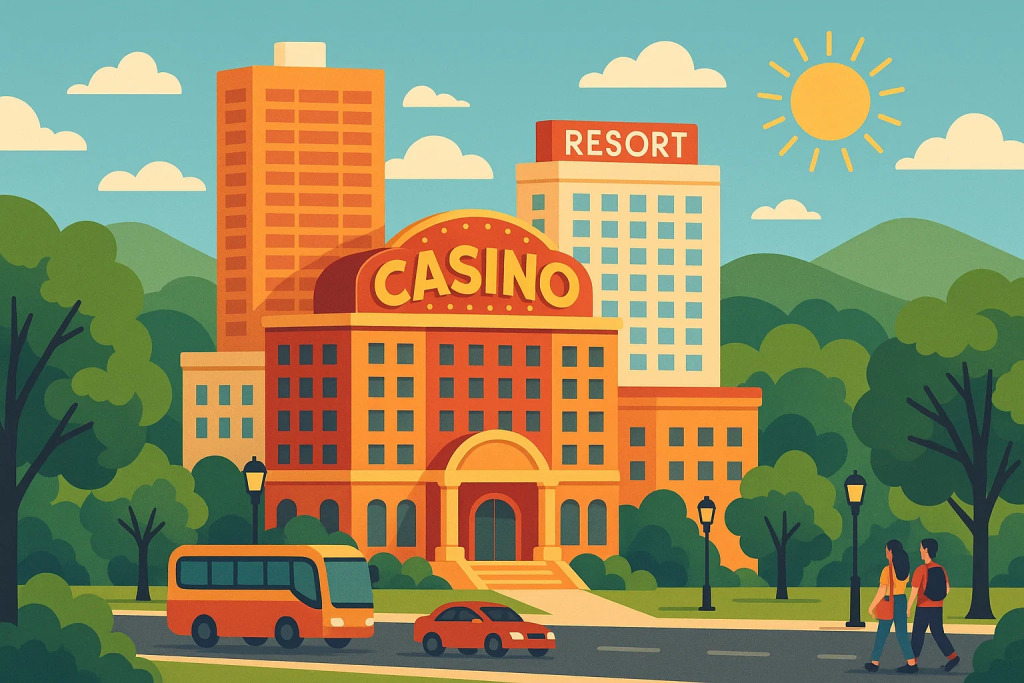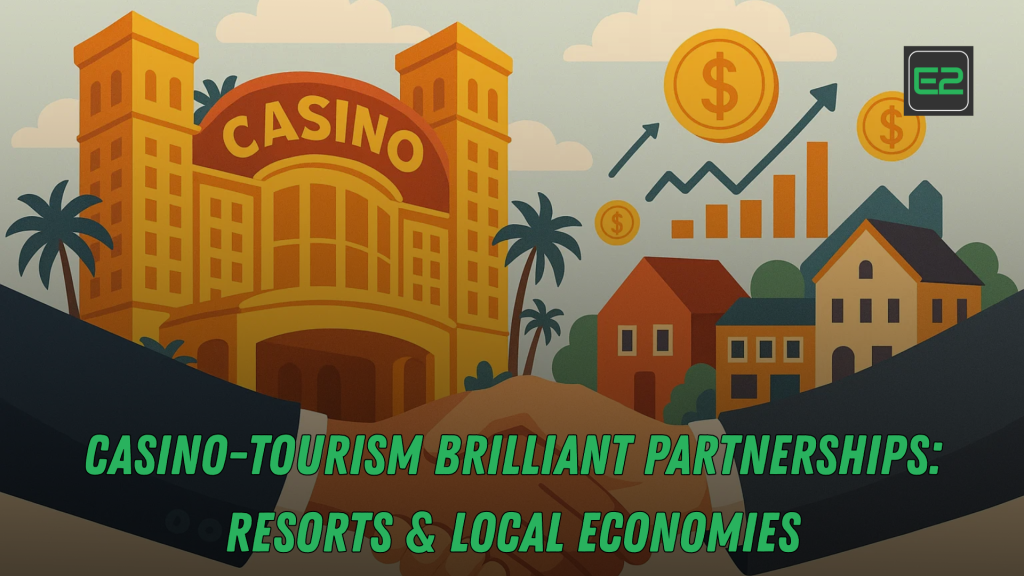Table of Contents
Executive Summary
Casino-tourism partnerships—when integrated resorts (IRs), local governments, tourism boards, SMEs, and communities work in lockstep—can convert a destination into a year-round economic engine. Done right, they create jobs, attract high-value visitors, catalyze infrastructure, expand the tax base, and stimulate new creative industries (events, food, arts). Done poorly, they risk leakage (profits flowing out), social costs, and reputational damage.
This practical playbook walks you through how to design, launch, and run a casino-tourism partnership that benefits both the resort and the region:
- The economic flywheel (why casinos plus tourism equal more than the sum of their parts)
- Ownership and partnership models that align incentives
- A licensing & governance checklist that builds public trust
- Product & experience design: MICE, entertainment, retail, wellness, F&B, family-friendly layers
- Marketing & loyalty that convert stopovers into multi-night stays
- Payments, KYC/AML, and risk foundations for long-term credibility
- Responsible gaming and ESG safeguards to keep the social contract intact
- A 24-month rollout roadmap with KPIs, plus checklists for each stakeholder
- A FAQ to answer the most common investor, tourism, and policy questions

1) Why Casino-Tourism Partnerships Are Surging
1.1 The post-pandemic shift
Travelers want “everything in one trip”—events, dining, culture, retail, wellness, and entertainment. Integrated resorts bundle these in walkable districts, making them high-conversion hubs for weekenders and international visitors alike.
1.2 The regional multiplier
A well-run IR is more than a gaming floor. It’s a MICE magnet (Meetings, Incentives, Conferences, Exhibitions), concert venue, chef-driven dining hall, shopping promenade, and art showcase—a nucleus that spins off SME contracts, supplier development, and creative jobs.
1.3 The win-win logic
- Resorts gain predictable demand through city branding and airlift improvements.
- Cities/regions gain jobs, tourist spend, infrastructure investments, and new tax streams.
- Communities gain training pipelines, micro-enterprise opportunities, and public spaces.
2) The Casino-Tourism Economic Flywheel
Visualize a five-stage loop:
- Anchor investment (IR capex, public realm upgrades, mobility)
- Visitor magnet (events, MICE, entertainment calendar)
- Spending spillover (hotels, restaurants, tours, retail, nightlife)
- Supply chain & jobs (food suppliers, AV, staging, security, cleaning, tech)
- Reinvestment & brand lift (tax revenues → parks, transit; resort upgrades → new events)
Each loop reduces seasonality, lengthens average length of stay (ALOS), and raises Average Daily Rate (ADR) and RevPAR (revenue per available room). The more consistent your year-round calendar, the faster the flywheel.
Pro tip: Resist the temptation to measure success only by gaming win. Track total destination spend (on-property + off-property), repeat visitation, and SME participation.
3) Casino-Tourism Partnership Models: Aligning Incentives From Day One
3.1 Public-Private Partnership (PPP)
- Use when: The destination needs infrastructure (roads, water, transit, promenades) and the resort needs a predictable development timeline.
- Keys to success: Transparent risk-sharing, performance-based incentives, and clear community benefit agreements (CBAs).
3.2 Casino-Tourism Destination Consortium (Resort + DMO + Airport + Convention Bureau)
- Use when: You want unified airlift negotiations, co-op marketing, and event bidding (sports, concerts, expos).
- Keys: Shared KPIs (ALOS, ADR, event nights, load factors), joint creative budgets, and synchronized content calendars.
3.3 Cluster Play (Multiple Operators, One District)
- Use when: The goal is a walkable entertainment district with varied price points.
- Keys: A district management authority standardizes safety, signage, wayfinding, vendor permits, and late-night logistics.
3.4 University & Cultural Alliances
- Use when: You want programming density—culinary labs, arts residencies, esports, film festivals.
- Keys: IP clarity, student safety, and equitable revenue splits.
4) Casino-Tourism Licensing, Governance, and Public Trust
A credible license is a social contract. Bake in trust before opening day.
Licensing checklist:
- Ownership transparency (beneficial owners, conflict disclosures)
- KYC/AML systems, e-wallet governance, and transaction monitoring
- Independent responsible gaming framework (self-exclusion, spending tools, on-site counseling)
- Workforce standards (equal opportunity, anti-harassment, wage transparency)
- Procurement rules favoring local SMEs where feasible
- Ongoing third-party audits (financial, integrity, cybersecurity, ESG)
Governance guardrails:
- Independent compliance officer reporting to the board audit committee
- Data privacy & cybersecurity program (tokenization, encryption at rest/in transit)
- Whistleblower and retaliation-free reporting mechanisms
- Clear marketing codes (no targeting minors; guardrails on digital ads)
5) Casino-Tourism Designing the Destination Product (Beyond the Gaming Floor)
5.1 The “4-Stack” IR Blueprint
- Gaming & nightlife: Diverse table games, slots, live entertainment, lounges
- MICE & events: Scalable ballrooms, flexible breakout rooms, broadcast-ready AV
- Leisure & culture: Spa, rooftop pools, galleries, culinary incubators, live theater
- Retail & F&B: Flagship chefs + local heroes (hawker-style halls, artisanal markets)
5.2 Family-friendly layers
- Aquatic zones, interactive museums, edutainment for day-time traffic
- Festival streets with buskers, safe lighting, and stroller-friendly paths
5.3 Local flavor as a strategy
- Rotate regional cuisines and craft markets; commission public art; host heritage tours. Authenticity increases time on site and shareability.
6) Programming the Year-Round Calendar of Casino-Tourism
Anchor tentpoles (book 12–18 months out):
- International music acts, culinary festivals, esports majors, boxing/MMA cards
Shoulder fillers (3–6 months): - Regional expos, university alumni weekends, holiday markets, wellness retreats
Weekly cadence (rolling 8 weeks): - Resident DJ nights, chef collabs, maker fairs, rooftop cinema, family Sundays
Rule of thirds: ⅓ big draws, ⅓ niche passions, ⅓ community-first events. This smooths seasonality and diversifies audiences.
7) Casino-Tourism Marketing & Loyalty: From Click to Stay to Return
7.1 Segmentation
- MICE buyers: planners, corporates, associations
- Premium leisure: foodies, concertgoers, spa patrons
- Regional short-haul: weekenders, friends & families
- Bleisure travelers: extend business trips with leisure add-ons
7.2 Funnels that work
- Search + social + creators: destination teasers → event reveals → IR packages
- Co-op campaigns: joint ads with airlines and DMOs; fare + room bundles
- Loyalty tiers: gaming and non-gaming earn rates; unify hotel, dining, retail, spa
7.3 Offer architecture
- Lure: early-bird event packages, “kids eat free” Sundays, spa-dine bundles
- Lock: flexible cancellation, free transit passes, priority event seating
- Love: member lounges, birthday perks, concierge chat, surprise upgrades
KPI set: CPA (cost per acquisition), conversion by segment, ALOS, ADR, per-guest spend (gaming/non-gaming), repeat rate by cohort.
8) Casino-Tourism Digital Payments, AML/KYC & Risk Foundations
8.1 Payments experience
- Omnichannel wallets (contactless on property), QR F&B, self-checkout retail
- Foreign exchange transparency and dynamic currency tools for international guests
8.2 AML/KYC essentials
- Tiered KYC onboarding, transaction monitoring with velocity checks
- Sanctions screening and beneficial ownership checks for VIP/corporate clients
- Data retention policies aligned with local regulation; immutable audit trails
8.3 Cyber & fraud controls
- Network segmentation, EDR, MFA, red-team testing
- Chargeback playbooks, bot detection, and real-time rules tuning
9) Casino-Tourism Responsible Gaming: Keep the Social Contract
- On-site counseling and trained RG ambassadors
- Self-exclusion portals, time-out options, personalized spend controls
- Ad standards: no minors, disclaimer clarity, RG messaging in loyalty comms
- Data ethics: use analytics to identify risk patterns, not to exploit vulnerability
- Community fund: a fixed portion of gaming revenue dedicated to prevention and treatment programs
10) Workforce & Supplier Development
10.1 Talent pipeline
- Partnerships with hospitality schools, culinary institutes, and TVET centers
- Apprenticeships for housekeeping, culinary, AV, facilities, and security tech
- Leadership tracks for women and underrepresented groups
10.2 SME & local sourcing
- Vendor fairs and simplified RFP templates
- Timely payment terms and micro-financing for small suppliers
- Quality coaching (food safety, packaging, scalable production)
Measure: % local hires, % local suppliers, training hours per FTE, promotion velocity, supplier survival after 12/24 months.
11) Casino-Tourism Infrastructure & Mobility: Access Is an Amenity
- Airlift & route development: co-funded marketing with airlines, red-eye recovery plans
- Transit links: shuttle loops, last-mile e-buses, safe walkways, bike parking
- Wayfinding: multilingual signage, color-coded districts, tactile guidance for accessibility
- Operations: curb management for rideshare, freight windows for vendors, noise control after events

12) ESG & Community Impact
12.1 Environmental
- Solar roofs, greywater reuse, smart HVAC, LEDs, composting and F&B waste tracking
- Green procurement for paper, plastics, linens, amenities
12.2 Social
- Scholarships, reading corners in lobbies, school sport grants, volunteer days
- Safe-space commitments (anti-harassment, inclusive bathrooms, accessibility audits)
12.3 Governance
- ESG dashboard published annually, third-party assurance
- Board-level oversight for integrity and RG
13) Data, Dashboards & KPIs That Matter
Core metrics:
- Tourism: arrivals by market, ALOS, ADR, RevPAR, event room nights
- Economy: jobs created (direct/indirect), payroll, SME contracts, tax revenue
- Experience: NPS by segment, complaint resolution time, mobile app satisfaction
- RG/ESG: self-exclusions, counseling engagements, energy/water intensity, local hire ratio
- Risk: fraud loss %, chargeback rate, AML alerts resolved within SLA
Cadence: Daily ops dashboard; weekly commercial stand-ups; monthly board snapshot; quarterly community report.
14) Risk Register: Plan for What Can Go Wrong
- Regulatory changes: maintain a policy watch; scenario map fee/tax sensitivities
- Seasonality shocks: diversify programming; partner with universities and sports leagues
- Reputation events: crisis comms playbook; factsheet hubs; third-party validators
- Capital cost spikes: phased development; modular spaces; value engineering guardrails
- Talent churn: retention bonuses tied to training, housing partnerships, transparent progression
15) 24-Month Roadmap (From MoU to Momentum)
Months 0–3: Vision & Guardrails
- Sign MoU (IR + city + DMO + airport + convention bureau).
- Publish Community Benefits Agreement and Responsible Gaming Charter.
- Launch stakeholder town halls; open vendor registry.
Months 4–6: Design & Data
- Finalize masterplan (zoning, mobility, utilities, ESG targets).
- Build baseline tourism/economy dashboard; agree shared KPIs.
Months 7–9: Early Wins
- Pilot festival street weekends; pop-ups with local chefs and makers.
- Co-op marketing with airlines; soft-open loyalty app (non-gaming earn).
Months 10–12: MICE & Talent
- Bid for 3–5 marquee events (12–18 months out).
- Sign MOUs with schools; launch apprenticeship cohorts.
Months 13–18: Build & Book
- Lock entertainment residencies; announce culinary headliners.
- Commission public art; reveal district wayfinding; test e-bus loop.
Months 19–24: Grand Opening & Scale
- Phased opening: retail & F&B → MICE → rooms → gaming (as licensed).
- First year headline festival; publish Year-1 Impact Report and ESG Scorecard.
16) Case Snapshots (Anonymized Patterns You Can Emulate)
Case A: Waterfront IR District
- Problem: High seasonality and short stays.
- Moves: Weekly waterfront night market, culinary residencies, e-bus link to old town.
- Results: +1.1 nights ALOS, 28% non-gaming spend lift, 40% vendor base local.
Case B: University-Linked MICE Pivot
- Problem: Under-utilized ballroom between mega events.
- Moves: Academic symposium series, esports weekends, hybrid broadcast studio.
- Results: +19% shoulder-month room nights, new sponsorship categories (tech, education).
17) Practical Checklists
For Resorts & Developers
- Finalize RG program (self-exclusion, on-site counseling)
- KYC/AML tech, fraud rules, data retention & privacy
- Local vendor strategy (targets, onboarding, payment terms)
- MICE calendar: 12-month tentpoles booked
- ESG investments (solar, water, waste KPIs)
For Cities & DMOs
- District management: safety, permits, wayfinding
- Airlift strategy with airport & airlines
- SME training grants; creative industry incubators
- Public realm (lighting, shade, parks) around the venue
- Transparent quarterly community impact updates
For SMEs & Cultural Groups
- Food safety & packaging standards in place
- Pricing and volume plans for event surges
- Digital presence (menu/photos, booking, maps)
- Co-marketing content with the DMO
- Vendor insurance and simple bookkeeping
18) Content & Storytelling: Make It Shareable
- Creator partnerships: behind-the-scenes of kitchens, stage rigging, costume rooms
- Mini-docs: origin stories of local chefs, artists, bands
- Family formats: treasure hunts, stamp cards, passport-style itineraries
- Corporate tools: event playbooks, budget calculators, sample rundowns
- Localization: multilingual captions, subtitling, community hashtags
19) The Bottom Line
Casino-tourism partnerships thrive on clarity and trust—clear rules, visible community benefits, and hospitality that celebrates local culture. If you build a place where visitors stay longer and locals prosper, your resort becomes more than a property; it becomes part of the region’s identity and growth story.
Strong Call-to-Action (CTA)
Ready to turn a property into a destination flywheel? Tell me your city, audience mix, opening window, and KPIs (ALOS, ADR, job targets). I’ll send back a custom 12-month event calendar, co-op marketing map, and a local vendor playbook you can deploy this quarter—so your casino-tourism partnership delivers measurable wins from day one.
FINAL WORD
The best casino-tourism partnerships are coalitions: resorts, governments, tourism boards, schools, artists, airlines, and small businesses rowing in the same direction. With the right governance, memorable programming, and community-first economics, your integrated resort won’t just attract visitors—it will lift an entire local economy for years to come.
The playbook explains how casino-tourism partnerships—anchored by integrated resorts (IRs) working with cities, tourism boards, airports, universities, and SMEs—can supercharge local economies when trust, governance, and community benefits are built in from day one. It outlines an economic flywheel: anchor investment → event and MICE magnet → off-property spending → supply-chain jobs → reinvestment and brand lift. To align incentives, it recommends models like PPPs, destination consortia, cluster districts, and cultural/academic alliances, all enforced by transparent licensing, AML/KYC, data privacy, and independent responsible-gaming programs.
Casino-Lobby Catastrophe: Online-Betting Bill Sparks Firestorm
Beyond gaming, winning destinations design a four-stack product—gaming/nightlife, MICE/events, leisure/culture, retail/F&B—with family-friendly layers and authentic local flavor. A year-round calendar (tentpoles, shoulder fillers, weekly cadence) smooths seasonality, while segmented marketing, co-op airline campaigns, and unified loyalty convert clicks to longer stays and repeat visits. The guide details digital payments, cyber and fraud controls, workforce pipelines, SME sourcing, mobility and wayfinding, plus ESG commitments (energy, water, waste; scholarships and safe spaces).

Success is tracked via dashboards covering tourism, economic impact, guest experience, RG/ESG, and risk. A 24-month roadmap moves from MoU and CBAs to phased opening and an impact report, supported by practical checklists and FAQs. The core message: design for spillovers, accountability, and community first.
Frequently Asked Questions (FAQ)
1) Do casino-tourism partnerships only work in big cities?
No. Mid-sized and secondary cities can excel if they have a strong theme or cluster (waterfront, heritage, sports, wellness), easy access, and consistent programming. The key is a right-sized venue and a co-op marketing network with airlines, DMOs, and universities.
2) How do we measure success beyond gaming revenue?
Track ALOS, ADR, RevPAR, non-gaming spend, SME contracts, local hires, MICE room nights, repeat visitation, and RG/ESG metrics. Publish a quarterly community impact dashboard to keep the social contract visible.
3) Won’t a casino cannibalize local businesses?
Not if you design for spillovers: vendor stalls, chef collaborations, shuttle loops to old town, and co-ticketing with museums and tours. Structure procurement and programming to pull SMEs in, not push them out.
4) What are the non-negotiables for responsible gaming?
Independent RG governance, self-exclusion, time-out tools, ad guardrails, staff RG training, and data ethics. Tie a community fund to gaming revenue for prevention and treatment services.
5) What’s the fastest path to early wins before full opening?
Start with pop-ups and festival streets, co-market with airlines, soft-launch loyalty (non-gaming earn), and book tentpole events 12–18 months ahead. Release a transparent CBA and ESG roadmap to build trust early.
